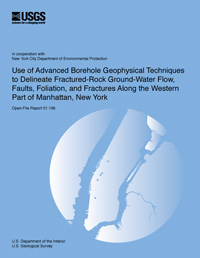 Use of Advanced Borehole Geophysical Techniques to Delineate Fractured-Rock
Ground-Water Flow, Faults, Foliation, and Fractures along the Western Part of Manhattan, New York
Use of Advanced Borehole Geophysical Techniques to Delineate Fractured-Rock
Ground-Water Flow, Faults, Foliation, and Fractures along the Western Part of Manhattan, New York
by Frederick Stumm, Anthony Chu, and Andrew D. Lange
U.S. GEOLOGICAL SURVEY
Open-File Report 01-196
ABSTRACT
Advanced borehole-geophysical methods
were used by the U.S. Geological Survey in cooperation
with the New York City Department of
Environmental Protection (NYCDEP) to assess
the geohydrology of crystalline bedrock at three
test boreholes (W34ST-B, W37ST-A, and
W55ST-A) on the western side of Manhattan
Island, N.Y., in preparation for construction of a
third water tunnel for New York City by the
NYCDEP. The borehole-logging methods
included natural gamma, single-point resistance,
mechanical and acoustic caliper, focused electromagnetic
induction, magnetic susceptibility, borehole-
fluid temperature and resistivity, heat-pulse
and EM (electromagnetic) flowmeter, borehole
deviation, acoustic and optical televiewer, and
borehole radar. The boreholes penetrated gneiss
and other crystalline bedrock with an overall
southwest-to-northwest dipping foliation. Most of
the fractures encountered are either nearly horizontal
or have moderate to high-angle northwest
dip azimuths. Foliation within the tunnel-construction
zone is southwest-to-northwest dipping,
with fractures that average a northwest dip azimuth.
EM and heat-pulse flowmeter logs obtained
under pumping and ambient conditions, together
with other geophysical logs, indicate transmissive
fracture-flow zones in each borehole. The
60-megahertz directional borehole radar logs
delineated the location and orientation of radar
reflectors that would intersect the projection of the
borehole above or below the drilled depth. Borehole
data and interpretations may not reflect the
exact location of the proposed tunnel-construction
zone because of borehole deviation and constraints
on borehole placement.
Fracture indexes range from 0.25 to 0.44 fracture
per foot of borehole. The three-dimensional
orientation of the fractures indicates a highly
transmissive fracture zone at 328 to 330 feet
below land surface (BLS) (-287.73 to -289.73 feet
elevation) in W34ST-B that may intersect the proposed
tunnel-construction zone to about 220 feet
northwest of the borehole. Analysis of pumping
tests of each borehole indicates that their total
transmissivity ranges from 11 to 360 feet squared
per day; the highest transmissivity is at the middle
borehole (W37ST-A).
Citation: Stumm, F., Chu, A., and Lange, A.D., 2001,
Use of Advanced Borehole Geophysical Techniques to Delineate Fractured-Rock
Ground-Water Flow, Faults, Foliation, and Fractures along the Western Part of Manhattan, New York:
U.S. Geological Survey Open-File Report 01-196, 46 p.
 [Full Report, Acrobat PDF
(4.1M)]
[Full Report, Acrobat PDF
(4.1M)]
[an error occurred while processing this directive]
|
